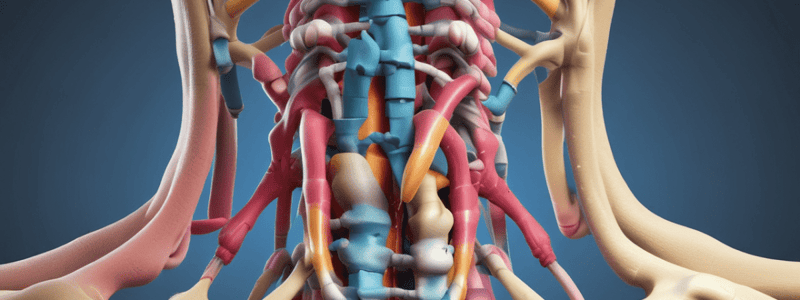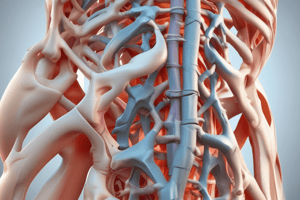Podcast
Questions and Answers
The ligamentum flavum limits forward flexion, particularly in the thoracic area.
The ligamentum flavum limits forward flexion, particularly in the thoracic area.
True (A)
The posterior longitudinal ligament reinforces the anterior portion of the anulus fibrosus.
The posterior longitudinal ligament reinforces the anterior portion of the anulus fibrosus.
False (B)
The ligamentum flavum is broad in the lumbar region.
The ligamentum flavum is broad in the lumbar region.
False (B)
The supraspinous ligaments limit extension.
The supraspinous ligaments limit extension.
The anterior atlantoaxial ligament is a continuation of the posterior longitudinal ligament.
The anterior atlantoaxial ligament is a continuation of the posterior longitudinal ligament.
Ligaments resist distraction, translation, and rotation of vertebral bodies.
Ligaments resist distraction, translation, and rotation of vertebral bodies.
The tectorial membrane limits forward flexion.
The tectorial membrane limits forward flexion.
The ligamentum nuchae limits forward flexion in the cervical region.
The ligamentum nuchae limits forward flexion in the cervical region.
The ligamentum flavum is well developed in the lumbar region.
The ligamentum flavum is well developed in the lumbar region.
The alar ligaments resist forward flexion and axial rotation in the lumbar region.
The alar ligaments resist forward flexion and axial rotation in the lumbar region.
Posterior atlantoaxial ligament is weak in the cervical region.
Posterior atlantoaxial ligament is weak in the cervical region.
The iliolimbar ligament primarily resists anterior sliding of L5 and S1.
The iliolimbar ligament primarily resists anterior sliding of L5 and S1.
The zygapophyseal joint capsules limit contralateral lateral flexion in the lumbar region.
The zygapophyseal joint capsules limit contralateral lateral flexion in the lumbar region.
The intertransverse ligaments are strongest at the thoracolumbar junction.
The intertransverse ligaments are strongest at the thoracolumbar junction.
Intervertebral junctions provide levers for muscles and ligaments to restrict movement.
Intervertebral junctions provide levers for muscles and ligaments to restrict movement.
Apophyseal joints connect an intervertebral disc with a pair of vertebral bodies.
Apophyseal joints connect an intervertebral disc with a pair of vertebral bodies.
Arthrokinematics describe coupled movements in a motion segment.
Arthrokinematics describe coupled movements in a motion segment.
The movement within any given intervertebral junction is typically large.
The movement within any given intervertebral junction is typically large.
Coupled motions are primary movements that consistently accompany a secondary motion.
Coupled motions are primary movements that consistently accompany a secondary motion.
Axial rotation is defined by the direction of movement of a point on the posterior side of the vertebral body.
Axial rotation is defined by the direction of movement of a point on the posterior side of the vertebral body.
Joint approximation between L1 and L2 is usually caused by a compression force.
Joint approximation between L1 and L2 is usually caused by a compression force.
Therapeutic traction is used to approximate the apophyseal joints.
Therapeutic traction is used to approximate the apophyseal joints.
Sliding (gliding) between joint surfaces is caused by a distraction force.
Sliding (gliding) between joint surfaces is caused by a distraction force.
Flexion-extension of the mid to lower cervical spine involves axial rotation.
Flexion-extension of the mid to lower cervical spine involves axial rotation.
Side bending to the right or left occurs in the frontal plane.
Side bending to the right or left occurs in the frontal plane.
Lateral flexion to the right or left involves medial-lateral movements.
Lateral flexion to the right or left involves medial-lateral movements.
Rotation, torsion, and axial rotation all refer to the same type of movement.
Rotation, torsion, and axial rotation all refer to the same type of movement.
Spinal coupling refers to the occurrence of pure lateral flexion and pure rotation in any region of the spine.
Spinal coupling refers to the occurrence of pure lateral flexion and pure rotation in any region of the spine.
During primary lateral bending, there is ipsilateral axial rotation in the thoracic spine.
During primary lateral bending, there is ipsilateral axial rotation in the thoracic spine.
The smallest functional unit in the spine includes three adjacent vertebrae.
The smallest functional unit in the spine includes three adjacent vertebrae.
Coupling patterns in the spine are solely determined by preexisting posture.
Coupling patterns in the spine are solely determined by preexisting posture.
Pure lateral flexion always occurs independently without any associated movement.
Pure lateral flexion always occurs independently without any associated movement.
During primary axial rotation, there is contralateral coupled lateral bending in the lumbar spine.
During primary axial rotation, there is contralateral coupled lateral bending in the lumbar spine.
The automatic movement associated with vertebral column movement only occurs in one plane.
The automatic movement associated with vertebral column movement only occurs in one plane.
Spinal coupling is a static phenomenon that does not involve any movement.
Spinal coupling is a static phenomenon that does not involve any movement.
The most consistent coupling pattern in the middle and lower cervical spine involves ipsilateral lateral flexion and contralateral axial rotation.
The most consistent coupling pattern in the middle and lower cervical spine involves ipsilateral lateral flexion and contralateral axial rotation.
Flashcards are hidden until you start studying




